Design and Implementation of an IoT-Oriented Energy Management System Based on Non-Intrusive and Self-Organizing Neuro-Fuzzy Classification as an Electrical Energy Audit in Smart Homes
Abstract
Featured Application
Abstract
1. Introduction
2. Design and Implementation of IoT-Oriented Smart HEMS Having the Proposed Novel Hybrid UAC-NFC Model Applied for NILM
2.1. IoT-Oriented Smart HEMS
2.2. Novel Hybrid UAC-NFC Model
- (1)
- The center parameter of Gaussian membership function j on universe of discourse i is initialized by component i of cluster center j, where i = 1, 2, …, n; n is the total number of universes of discourse (input variables); j = 1, 2, …, NMF; and NMF, which equals k in the UAC process, is the total number of Gaussian membership functions (cluster centers) on each of universes of discourse. There are k clusters resulting in k × k fuzzy partitions in a feature space as the partition space in fuzzy logic. The partition space containing k × k fuzzy partitions is square to the UAC used in this article. The value of k is identified through the UAC process, nearest-neighbor clustering.
- (2)
- The spread/width parameter of Gaussian membership function j on universe of discourse i is initialized by:where is component i of a data point that belongs to cluster j with the computed maximum distance between it and one data point in the same cluster and α, a real number, is a non-zero constant.
- (3)
- Based on the results by the UAC process, heuristically allocate the singleton parameters of Equation (3) with the desired output of collected input-output data pairs. The output of the NFC used in this article is defined as the class {0, 1, 2, …} of load combinations classified. Each single parameter is assigned a unique class label: class label 0, class label 1, class label 2, …, or class label w.
3. Experiment
4. Conclusions and Future Work
Author Contributions
Funding
Acknowledgments
Conflicts of Interest
References
- Koolen, D.; Sadat-Razavi, N.; Ketter, W. Machine Learning for Identifying Demand Patterns of Home Energy Management Systems with Dynamic Electricity Pricing. Appl. Sci. 2017, 7, 1160. [Google Scholar] [CrossRef]
- Tsai, M.S.; Lin, Y.H. Modern development of an adaptive non-intrusive appliance load monitoring system in electricity energy conservation. Appl. Energy 2012, 96, 55–73. [Google Scholar] [CrossRef]
- Ayub, M.A.; Ul Hassan, N.; Yuen, C. Hybrid iterative algorithm for non-intrusive load disaggregation. In Proceedings of the 2018 IEEE International Conference on Communications (ICC), Kansas City, MO, USA, 20–24 May 2018; pp. 1–6. [Google Scholar]
- Du, L.; Restrepo, J.A.; Yang, Y.; Harley, R.G.; Habetler, T.G. Nonintrusive, self-organizing, and probabilistic classification and identification of plugged-in electric loads. IEEE Trans. Smart Grid 2013, 4, 1371–1380. [Google Scholar] [CrossRef]
- Dong, M.; Meira, P.C.M.; Xu, W.; Chung, C.Y. Non-intrusive signature extraction for major residential loads. IEEE Trans. Smart Grid 2013, 4, 1421–1430. [Google Scholar] [CrossRef]
- Lin, Y.H.; Tsai, M.S. Non-intrusive load monitoring by novel neuro-fuzzy classification considering uncertainties. IEEE Trans. Smart Grid 2014, 5, 2376–2384. [Google Scholar] [CrossRef]
- Azaza, M.; Wallin, F. Evaluation of classification methodologies and Features selection from smart meter data. Energy Procedia 2017, 142, 2250–2256. [Google Scholar] [CrossRef]
- Chang, H.H. Non-intrusive demand monitoring and load identification for energy management systems based on transient feature analyses. Energies 2012, 5, 4569–4589. [Google Scholar] [CrossRef]
- Chang, H.H.; Chen, K.L.; Tsai, Y.P.; Lee, W.J. A new measurement method for power signatures of non-intrusive demand monitoring and load identification. IEEE Trans. Ind. Appl. 2012, 48, 764–771. [Google Scholar] [CrossRef]
- Tabatabaei, S.M.; Dick, S.; Xu, W. Toward non-intrusive load monitoring via multi-label classification. IEEE Trans. Smart Grid 2017, 8, 26–40. [Google Scholar] [CrossRef]
- Chang, H.H.; Lin, L.S.; Chen, N.M.; Lee, W.J. Particle swarm optimization based non-intrusive demand monitoring and load identification in smart meters. In Proceedings of the 2012 IEEE Industry Applications Society Annual Meeting (IAS), Las Vegas, NV, USA, 7–11 October 2012; pp. 1–8. [Google Scholar]
- Chang, H.H.; Lin, L.S.; Chen, N.M.; Lee, W.J. Particle swarm optimization based non-intrusive demand monitoring and load identification in smart meters. IEEE Trans. Ind. Appl. 2013, 49, 2229–2236. [Google Scholar] [CrossRef]
- Zeifman, M. Disaggregation of home energy display data using probabilistic approach. IEEE Trans. Consum. Electron. 2012, 58, 23–31. [Google Scholar] [CrossRef]
- Kolter, J.Z.; Johnson, M.J. REDD: A public data set for energy disaggregation research. In Proceedings of the SustKDD Workshop on Data Mining Applications in Sustainability (SIGKDD), San Diego, CA, USA, 21 August 2011; pp. 1–6. [Google Scholar]
- Kong, W.; Dong, Z.Y.; Ma, J.; Hill, D.J.; Zhao, J.H.; Luo, F.J. A hierarchical hidden markov model framework for home appliance modeling. IEEE Trans. Smart Grid 2018, 9, 3079–3090. [Google Scholar] [CrossRef]
- Kong, W.; Dong, Z.Y.; Ma, J.; Hill, D.J.; Zhao, J.H.; Luo, F.J. An extensible approach for non-intrusive load disaggregation with smart meter data. IEEE Trans. Smart Grid 2018, 9, 3362–3372. [Google Scholar] [CrossRef]
- Drenker, S.; Kader, A. Nonintrusive monitoring of electric loads. IEEE Comput. Appl. Power 1999, 12, 47–51. [Google Scholar] [CrossRef]
- Qi, B.; Liu, L.; Wu, X. Low-rate non-intrusive load disaggregation with graph shift quadratic form constraint. Appl. Sci. 2018, 8, 554. [Google Scholar] [CrossRef]
- Wang, H.; Yang, W. An iterative load disaggregation approach based on appliance consumption pattern. Appl. Sci. 2018, 8, 542. [Google Scholar] [CrossRef]
- Hasanien, H.M.; Matar, M. A fuzzy logic controller for autonomous operation of a voltage source converter-based distributed generation system. IEEE Trans. Smart Grid 2015, 6, 158–165. [Google Scholar] [CrossRef]
- Lin, Y.H.; Hung, S.K.; Tsai, M.S. Study on the influence of voltage variations for non-intrusive load identifications. In Proceedings of the Eighth International Power Electronics Conference (IPEC-Niigata 2018-ECCE Asia), Niigata, Japan, 20–24 May 2018; pp. 1575–1579. [Google Scholar]
- Lin, Y.H.; Tsai, M.S.; Chen, C.S. Applications of fuzzy classification with fuzzy C-means clustering and optimization strategies for load identification in NILM systems. In Proceedings of the 2011 IEEE International Conference on Fuzzy Systems (FUZZ-IEEE 2011), Taipei, Taiwan, 27–30 June 2011; pp. 859–866. [Google Scholar]
- Lin, C.T.; Lee, G.C.S. Neural Fuzzy Systems: A Neuro-Fuzzy Synergism to Intelligent Systems; Prentice Hall/Pearson Education Taiwan Ltd.: Taipei, Taiwan, 2003. [Google Scholar]
- Nomura, H.; Hayashi, I.; Wakami, N. A learning method of fuzzy inference rules by descent method. In Proceedings of the 1992 the IEEE International Conference on Fuzzy Systems, San Diego, CA, USA, 8–12 March 1992; pp. 203–210. [Google Scholar]
- Hagan, M.T.; Demuth, H.B.; Beale, M. Neural Network Design; PWS Pub. Co.: Boston, MA, USA, 1995. [Google Scholar]
- Roger, J.S. Data Clustering and Pattern Recognition. Available online: http://mirlab.org/jang (accessed on 7 August 2018).
- Chang, C.Y.; Kuo, C.H.; Chen, J.C.; Wang, T.C. Design and Implementation of an IoT Access Point for Smart Home. Appl. Sci. 2015, 5, 1882–1903. [Google Scholar] [CrossRef]
- ZigBee Alliance Homepage. Available online: http://www.zigbee.org/ (accessed on 28 September 2018).
- Tsai, M.S.; Lin, Y.H.; Chang, S.T. Decomposing power consumption on household appliances using non-intrusive load monitoring integrated with a home energy management system. In Proceedings of the 17th International Conference on Intelligent Systems Application to Power Systems (ISAP 2013), Tokyo, Japan, 1–4 July 2013. [Google Scholar]
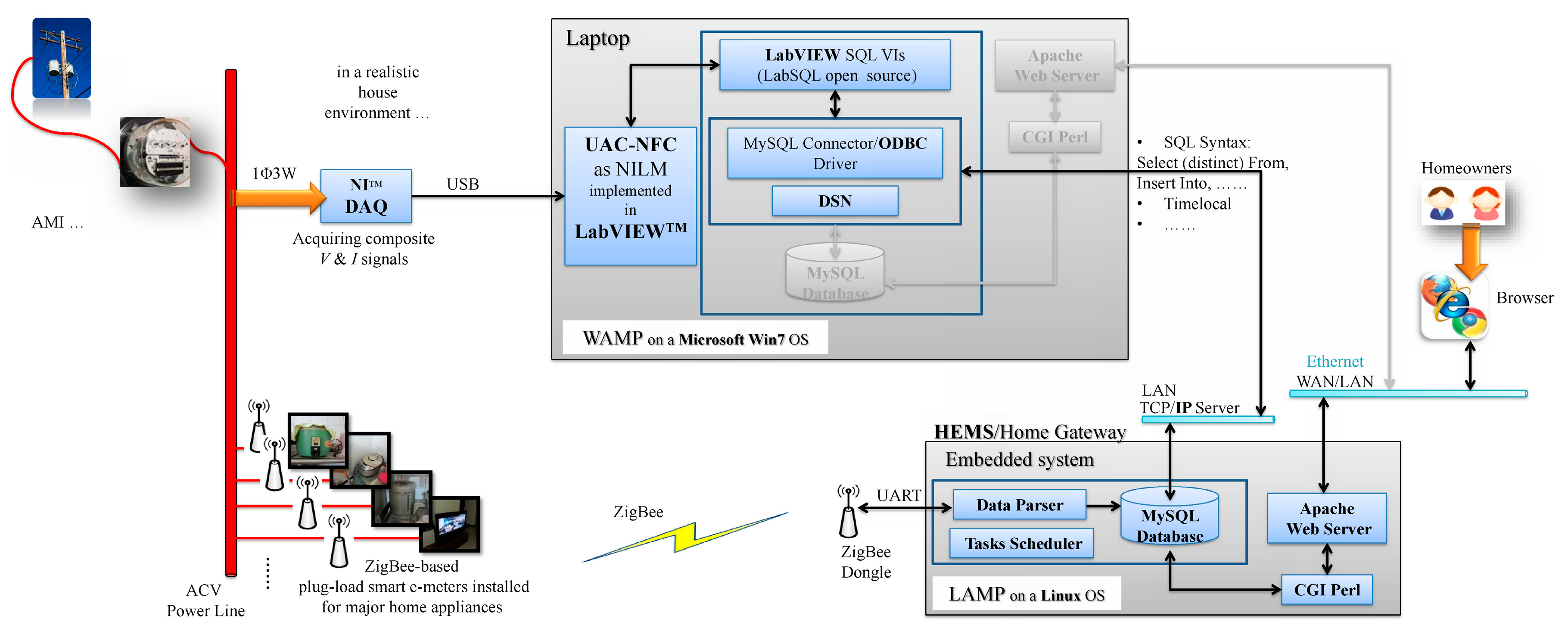
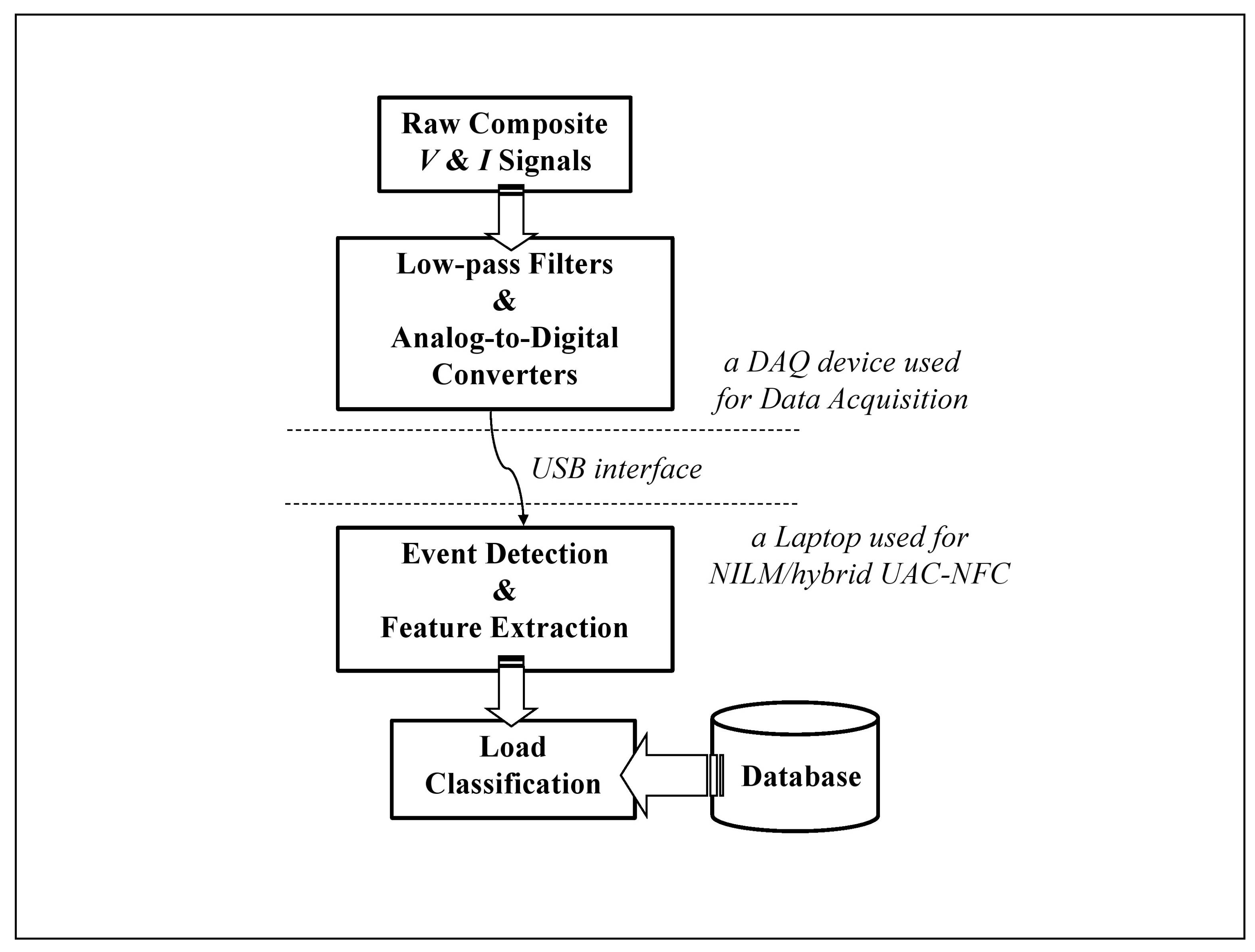
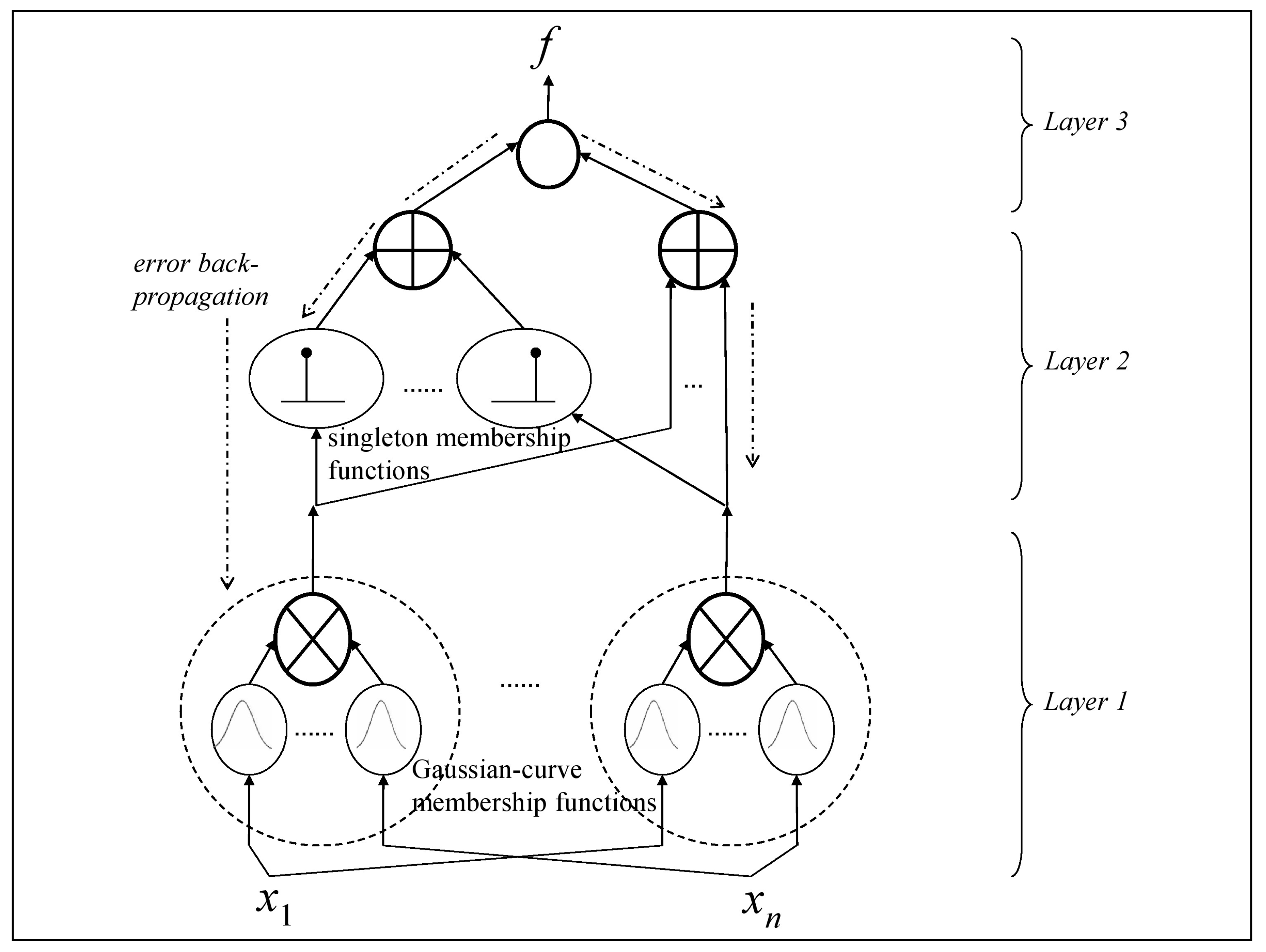

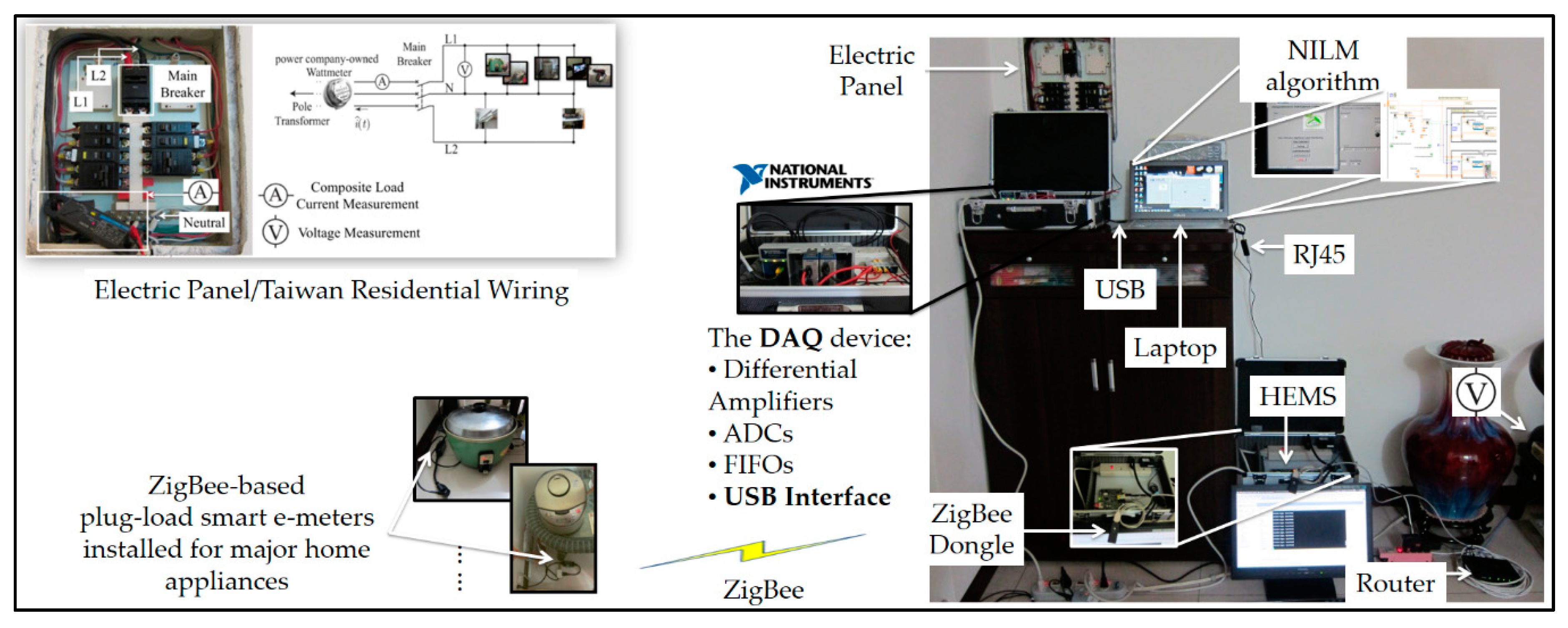
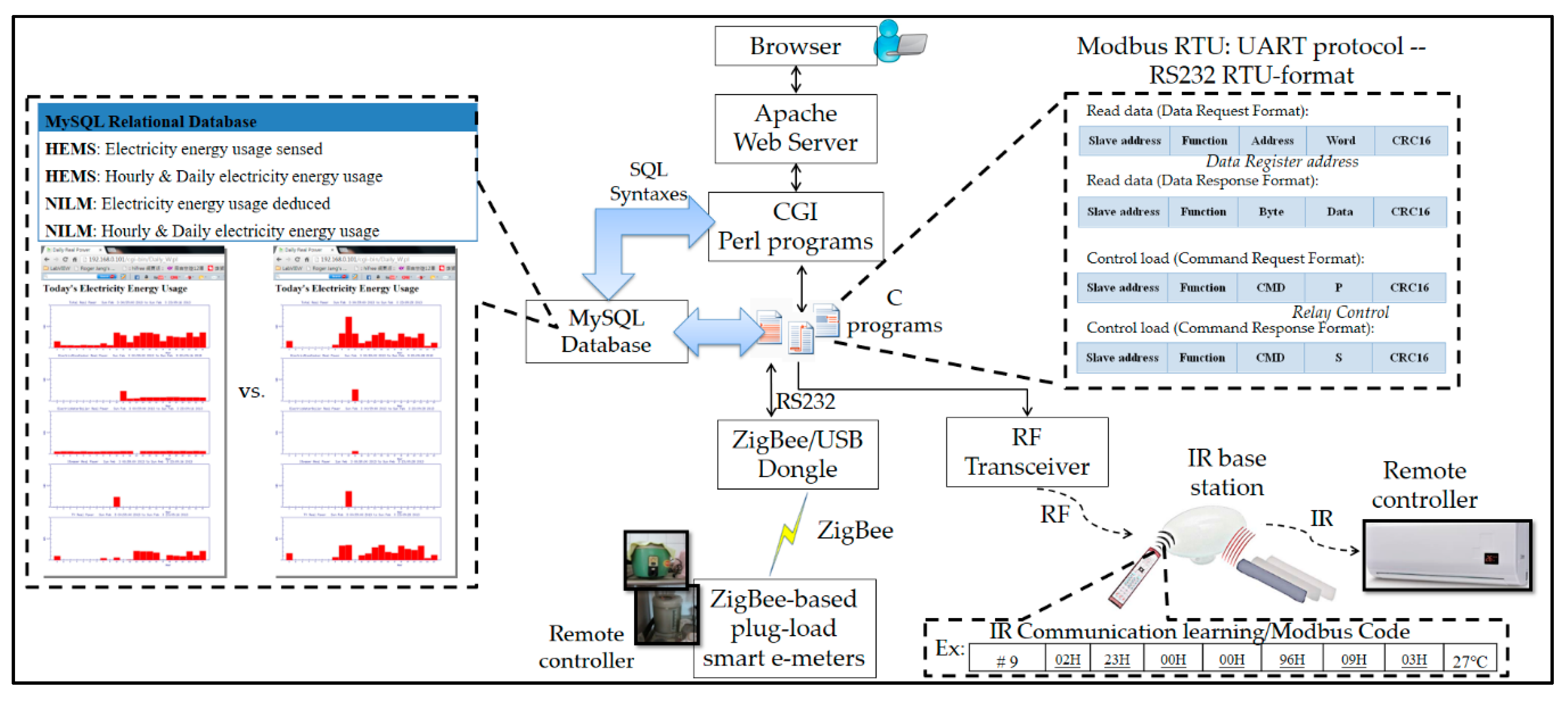
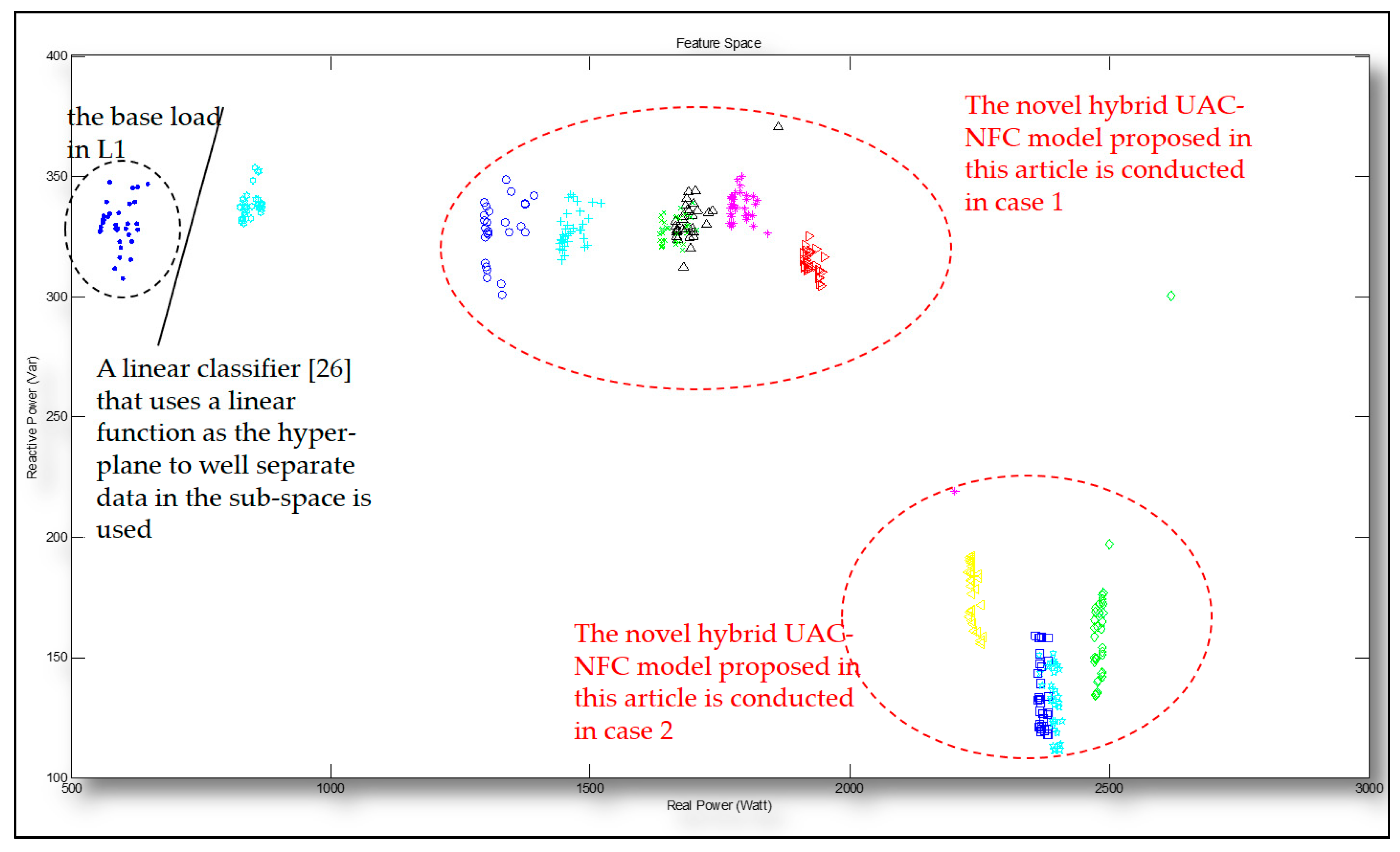
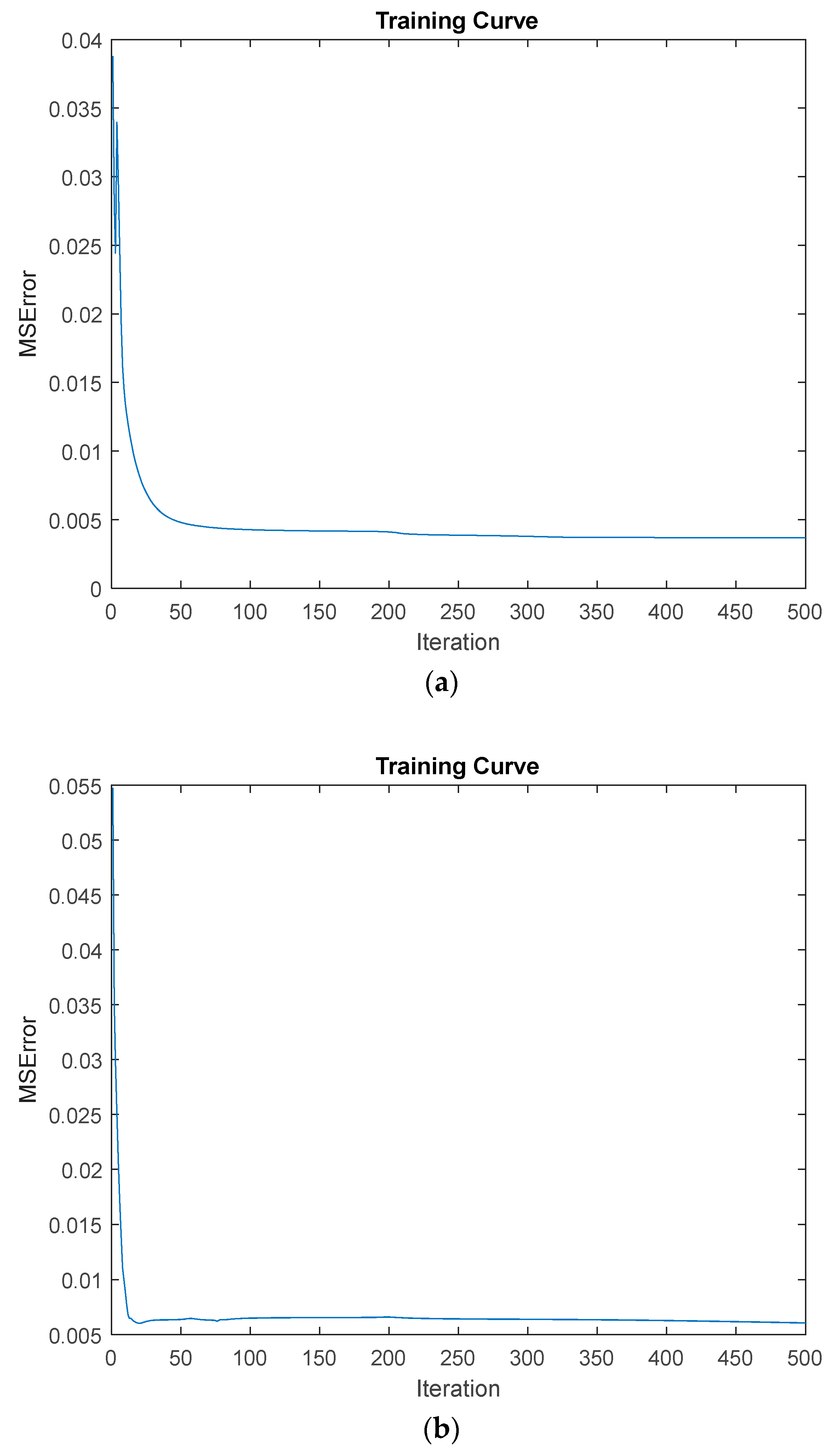
| Stage 1. Automatically construct the UAC-NFC model proposed in this article Inputs: D = {x1, x2, x3, …, xp, …, xN} // N input-output data pairs to be clustered automatically r // radius Output: K // Set of k clusters Run the UAC process: K1 = {x1}. // the first cluster initialized by x1 Add K1 to K. k = 1. for i = 2 to N Do // for x2, x3, …, xp, …, xN Find data point xm in cluster Km ⊂ K, where dist(xm, xi), the Euclidean distance between xm and xi, is the smallest. if dist(xm, xi) < r, then Km = Km ∪ {xi}. // the same cluster updated else k = k + 1. Kk = {xi}. // a new cluster created Add Kk to K. End for Initialize the adjustable parameters, , , and , of the NFC of Equation (2) based on the clustering results obtained through the UAC process above and described in Section 2.2. |
| Stage 2. Execute the GD process [22,23,24,25,26] to train the UAC-NFC model constructed in Stage 1 Do forq = 0 to qmax Do for p = 1 to N Do Present the pth input-output data pair (xp, yp), and compute the output of the NFC associated with the present data pair at the qth iteration of the training process in the forward propagation of the training process. Update the adjustable parameters of the NFC according to Equations (5)–(7), in the backward propagation of the training process. End for Obtain total error Σ|f(xp) − yp| with p = p + 1. End for While The NFC is not satisfactory with a high total error |
| Load Class !,* | Electric Rice Cooker | Electric Water Boiler | Steamer | Television |
|---|---|---|---|---|
| 0 | 0 | 0 | 0 | 0 |
| 1 | 0 | 0 | 0 | 1 |
| 2 | 0 | 0 | 1 | 0 |
| 3 | 0 | 0 | 1 | 1 |
| 4 | 0 | 1 | 0 | 0 |
| 5 | 0 | 1 | 0 | 1 |
| - | - | - | - | |
| - | - | - | - | |
| 8 | 1 | 0 | 0 | 0 |
| 9 | 1 | 0 | 0 | 1 |
| 10 | 1 | 0 | 1 | 0 |
| 11 | 1 | 0 | 1 | 1 |
| 12 | 1 | 1 | 0 | 0 |
| 13 | 1 | 1 | 0 | 1 |
| - | - | - | - | |
| - | - | - | - |
| NFC Used in Case 1 | NFC Used in Case 2 | |
|---|---|---|
| Centers | (0.0299, 0.7167) | (0.0256, 0.3450) |
| (0.1854, 0.7172) | (0.3653, 0.1191) | |
| (0.4023, 0.7175) | (0.4237, 0.1122) | |
| (0.4394, 0.7467) | (0.6574, 0.2661) | |
| (0.5587, 0.7604) | - | |
| (0.6956, 0.6266) | - | |
| Spreads | 0.3173 | 0.1973 |
| 0.1804 | 0.2255 | |
| 0.1398 | 0.2327 | |
| 0.4329 | 0.9554 | |
| 0.9756 | - | |
| 0.1384 | - |
| Classification Results | Novel Hybrid UAC-NFC Model Used in Case 1 | Novel Hybrid UAC-NFC Model Used in Case 2 |
|---|---|---|
| Overall classification rate ! in training (%) | 92.92 | 95.00 |
| Overall Classification rate in tests (%) | 95.83 | 95.63 |
| The averaged and generalized overall classification rate obtained in this experiment: 95.73%. | ||
© 2018 by the author. Licensee MDPI, Basel, Switzerland. This article is an open access article distributed under the terms and conditions of the Creative Commons Attribution (CC BY) license (http://creativecommons.org/licenses/by/4.0/).
Share and Cite
Lin, Y.-H. Design and Implementation of an IoT-Oriented Energy Management System Based on Non-Intrusive and Self-Organizing Neuro-Fuzzy Classification as an Electrical Energy Audit in Smart Homes. Appl. Sci. 2018, 8, 2337. https://doi.org/10.3390/app8122337
Lin Y-H. Design and Implementation of an IoT-Oriented Energy Management System Based on Non-Intrusive and Self-Organizing Neuro-Fuzzy Classification as an Electrical Energy Audit in Smart Homes. Applied Sciences. 2018; 8(12):2337. https://doi.org/10.3390/app8122337
Chicago/Turabian StyleLin, Yu-Hsiu. 2018. "Design and Implementation of an IoT-Oriented Energy Management System Based on Non-Intrusive and Self-Organizing Neuro-Fuzzy Classification as an Electrical Energy Audit in Smart Homes" Applied Sciences 8, no. 12: 2337. https://doi.org/10.3390/app8122337
APA StyleLin, Y.-H. (2018). Design and Implementation of an IoT-Oriented Energy Management System Based on Non-Intrusive and Self-Organizing Neuro-Fuzzy Classification as an Electrical Energy Audit in Smart Homes. Applied Sciences, 8(12), 2337. https://doi.org/10.3390/app8122337





